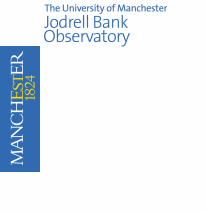PhD Projects 2008/2009
Pulsars provide the nearest thing to a physicist's dream come true. Being the end-point of stellar evolution, they are densest bodies next to black holes and give us an insight into the most extreme physical conditions of matter density, pressure and magnetic field observable by man. They also provide the most precise clocks known to humankind for undertaking unique experiments of gravitation and general relativity. Furthermore, they can be used as probes of the distribution of ionised material and magnetic field in the Galaxy with a precision which nothing else can. We use the telescopes at Jodrell Bank, Parkes (Australia), Arecibo (Puerto Rico), Westerbork (The Netherlands) and Effelsberg (Germany) in this work and frequently travel to the foreign instruments to make observations. The pulsar group at Jodrell Bank are arguably the most productive in the world in this area and have discovered more than three-quarters of the known population of these elusive and fascinating objects.
There are several main active areas of research in the general area of pulsar astronomy which would support projects which would be ideal for students, starting in September 2008. While we outline possible areas below, we can usually tailor projects to match a student's interest. In particular, we expect steady progress and new discoveries during the next year which are impossible to predict.
Last year saw the 40th anniversary of the discovery of pulsars. Still, so many years later, we still do not understand how pulsars really work. While we have a basic picture, many important problems still remain - despite significant advances that have been made recently with unexpected discoveries. One very promising way of learning more about pulsar emission, is the simultaneous observation of single radio pulses at a wide range of frequencies. Current models suggest that each frequency is created at a different height above the hot pulsar surface. Therefore, simultaneous multi-frequency observations provide slices through the stratified, highly magnetized pulsar magnetosphere. Previous experiments involving telescopes in the Netherlands, Germany, Italy and Jodrell Bank did not only provide a wealth of information but our European research collaboration was also awarded with the Descartes Prize of the European Union. In this PhD project, the student would analyze existing multi-frequency data, perform new experiments with telescopes around the world, and would interpret the data in order to gain insight into the creation of pulsar radio emission. (Note that a part-analysis of existing multi-frequency data can be addressed within a MSc project.)
Please contact Michael Kramer (Michael.Kramer@manchester.ac.uk) for further details.
At Jodrell Bank we have continued to make exciting new discoveries. Some of them have enlarged the family of known types of neutron stars. In addition to radio pulsars, Jodrell Bank astronomers discovered a class of Rotating Radio Transients (RRATS) which are identified as rotating neutron stars that send out very short flashes of radio light. Our current estimates suggest that these objects are four times more common in the Galaxy than radio pulsars.
Jodrell Bank astronomers have also discovered yet another class of neutron stars that are seemingly ordinary radio pulsars, but which are only active for some short time and in a quasi-periodic fashion. We call these "Intermittent Pulsars". The best studied member of this new class acts as a radio pulsar for about a week, before it is completely undetectable as a radio source for about a month. It then comes back to be as a radio again. Most surprisingly, we find that the pulsar rotation slows down faster when the pulsar is on than when it is off. This provides us with the best information about pulsar magnetospheres since their discovery.
Finally, the list of exotic radio emitting neutron star has become even longer with the discovery of radio pulses from so called magnetars. These extremely highly magnetized neutron stars were thought to be radio quiet but recent observations now allow insight into the creation of radio emission under very extreme conditions. The student working on this subject would preform observations of intermittent pulsars and magnetars, would be responsible for the analysis of the data and by comparing the observed properties of these objects would learn more about the variety and conditions of radio emission and their population in the Galaxy.
Please contact Michael Kramer (Michael.Kramer@manchester.ac.uk) for further details.
